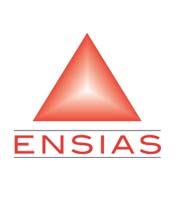- Accueil
-
L'Ecole
-
FORMATIONS
-
FORMATION INGENIEUR
-
Nouvelles filières offertes
- Ingénierie Intelligence Artificielle (2IA)
- Smart Supply Chain & Logistics (2SCL)
- Business Intelligence & Analytics (BI&A)
- Cybersécurité, Cloud et Informatique Mobile (CSCC)
- Data and Software Sciences (D2S)
- Génie de la Data (GD)
- Génie Logiciel (GL)
- Ingénierie Digitale pour la Finance (IDF)
- Smart System Engineering (SSE)
- REGLEMENT DES ETUDES DE L’ENSIAS CYCLE INGENIEUR
-
Nouvelles filières offertes
-
FORMATION INGENIEUR
- FORMATION CONTINUE
-
Recherche
- INTERNATIONAL
- ENTREPRISES
- VIE ESTUDIANTINE
- BIBLIOTHEQUE
LES DERNIÈRES INFORMATIONS
A hybrid bin-packing algorithm for solving the yard optimization problem
| Titre | A hybrid bin-packing algorithm for solving the yard optimization problem |
| Publication Type | Conference Paper |
| Year of Publication | 2017 |
| Authors | Chafik, R, Benadada, Y, Boukachour, J |
| Conference Name | Proceedings of the International Conference on Industrial Engineering and Operations Management |
| Abstract | Maritime container terminals are facilities where cargo containers are transshipped between ships or between ships and land vehicles (tucks or trains). They can be automated; semi-automated or static ones depend on the type of the equipments that they contain. There are crucial resources at container terminals; the yard, cranes and the vehicles. The yard refers to the temporary storage area where inbound, outbound containers can be stored. While we have two kinds of cranes depending on the type of the yard we are working on: yard crane and quay crane. Vehicles are used to transfer the container between the seaside and yard side (the external trucks XTs are not considerable in our study). The decision of the container stacking position is the most important operational task for the incoming containers which affects not only the productivity of the stacking but also for the later retrieval and also to avoid the unproductive moves to access to the requested containers stored in the stack. Our aim is to define a new approach to design the container stacking problem using an approach of optimization and simulation. Thus in this paper we will define a new MIP which has as objective the minimization of the number of the stacks used to store a given number of inbound containers, and to define afterwards a simulation model using a simulation software (Arena) which has as input the result of the optimization model. So we will try first to define a relocation model using the standard (FCFS) then the Best fit decrease (BFD) from the bin packing algorithm to store and maintain the storage area and to avoid unproductive moves and reshuffles to find out the requested container sequence. The main inputs are high, weight, destination and the delivery time of each container. Our objective is to have, based on heuristics, a guide to the planner to obtain an optimized stacking / reshuffling plan, given a stacking state and a container demand. We will try to minimize the number of reshuffles as well as the number of stacks used and obtaining a conclusion about possible yard configurations. © IEOM Society International. |
| URL | https://www.scopus.com/inward/record.uri?eid=2-s2.0-85019000218&partnerID=40&md5=9aebf3bb53d265a1dd55c143dac817a3 |
Revues:
LIENS UTILES
Localisation
Contactez-nous
ENSIAS
 Avenue Mohammed Ben Abdallah Regragui, Madinat Al Irfane, BP 713, Agdal Rabat, Maroc
Avenue Mohammed Ben Abdallah Regragui, Madinat Al Irfane, BP 713, Agdal Rabat, Maroc
![]() Télécopie : (+212) 5 37 68 60 78
Télécopie : (+212) 5 37 68 60 78
![]() Secrétariat de direction : 06 61 48 10 97
Secrétariat de direction : 06 61 48 10 97
Secrétariat général : 06 61 34 09 27
Service des affaires financières : 06 61 44 76 79
Service des affaires estudiantines : 06 62 77 10 17 / n.mhirich@um5s.net.ma
CEDOC ST2I : 06 66 39 75 16
Résidences : 06 61 82 89 77
Education - This is a contributing Drupal Theme
Design by WeebPal.
Design by WeebPal.



































